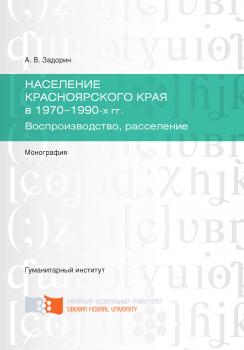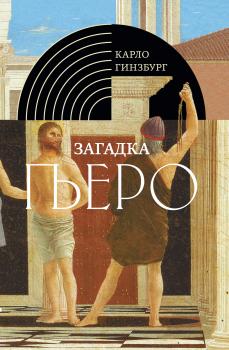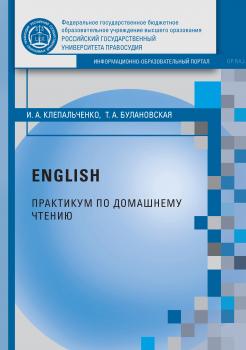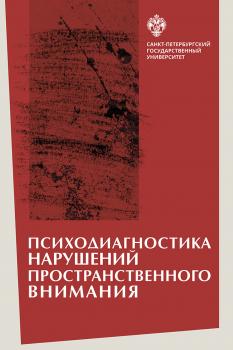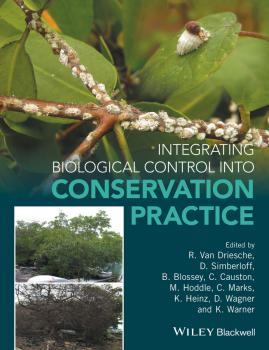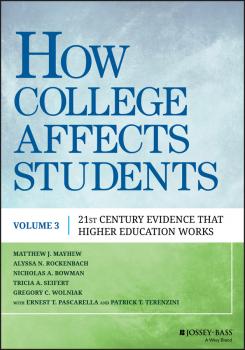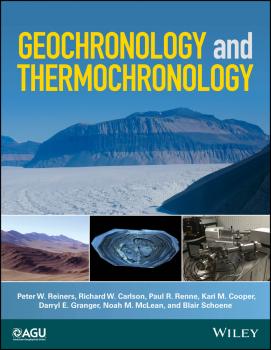Прочая образовательная литература
Различные книги в жанре Прочая образовательная литератураНаселение Красноярского края в 1970-1990-х гг. Воспроизводство, расселение
В монографии рассмотрены проблемы возникновения и развития процесса депопуляции в России и Красноярском крае. Впервые предпринята попытка комплексного исследования демографической истории Красноярского края с 1970 г. до начала XXI в. Выявлены взаимосвязи между экономическим и демографическим развитием региона в период двух красноярских десятилеток (1971–1990 гг.) и либеральных реформ 1990-х гг. Предназначена для научных работников, аспирантов, магистрантов, обучающихся по направлению 46.04.01 «История». Может быть интересна широкому кругу читателей.
«Пьяный вопрос» в России и «сухой закон» 1914-1925 годов. Том 1. От корчмы до винных акцизов Александра II
В первом томе монографии рассматривается процесс развития питейной политики российского государства начиная с древнейших времен до введения акцизной системы во второй половине XIX в.; прослеживаются неудачные попытки царей Бориса Годунова и Алексея Михайловича Романова борьбы с пьянством; исследуется влияние реформ Петра I и его Всепьянейшего Собора на увеличение потребления алкоголя в России; освещается становление дворянской винной монополии на производство водки, питейная политика российского государства во время акцизной реформы Александра II. Предназначена для аспирантов, преподавателей и научных работников.
Загадка Пьеро. Пьеро делла Франческа
Знаменитая монография Карло Гинзбурга «Загадка Пьеро» (1981)—интеллектуальный бестселлер и искусствоведческий детектив, построенный вокруг исторической интерпретации фресок итальянского художника XV века Пьеро делла Франческа. Автор решительно отходит от стилистической трактовки живописи и предпочитает ей анализ социально-исторических, политических, житейских и прочих обстоятельств, сопровождавших создание шедевров Пьеро. Смысл картин Пьеро оказывается связан с повседневной жизнью самого живописца, его заказчиков и их покровителей. Увлекательно написанное исследование содержит несколько приложений, в одном из которых Гинзбург указывает на допущенную им самим ошибку в первом издании труда,—так текст монографии превращается в рефлексию историка над природой собственного ремесла. К. Гинзбург (р. 1939)—известный итальянский ученый-гуманитарий, один из создателей «микроисторического» метода, автор многих книг и статей, посвященных интеллектуальной истории эпохи Возрождения, Нового и Новейшего времени.
Ноосфера – планета разума
В данной монографии на глубочайшем научном фундаменте представляются этапы зарождения и эволюция всего мира – от вселенных, галактик и до Солнца, Земли с ее природой и человечеством. И весь этот видимый и невидимый мир является генетически единой энергоинформационной системой мироздания Вселенной, созданной, живущей и развивающейся по единым законам Вселенной. Наша Земля и природа, а также все человечество и все живущее на Земле являются неотъемлемой частью всей системы мироздания и так же, как и весь мир, живут и развиваются по вселенским законам. Это величайшее открытие получило научно-практическую основу для дальнейшего развития и позволило рассчитать все этапы творения и развития мира в мегапроекте «Великое сокрестие континентов – стратегическая модель космопланетарной интеграции планеты Земля в ноосфере», разрабатывающемся плеядой великих ученых мира под эгидой ЮНЕСКО в течение более 45 лет. Презентации этого мегапроекта была посвящена I Международная научно-практическая конференция «Ноосфера – планета разума», прошедшая с 1 июня по 27 июля 2015 года в Москве. Программа мегапроекта была рассмотрена и одобрена Генеральным директором ЮНЕСКО И.Г. Боковой, которая проявила заинтересованность в том, чтобы и в дальнейшем поддерживать контакты по проекту. Сборник материалов и докладов конференции составлен автором концепции, руководителем Международного мегапроекта, академиком Российской академии космонавтики им. К.Э. Циолковского Пюрвеевым Джангаром Бадмаевичем.
English. Практикум по домашнему чтению. Упражнения по произведению Дж. Гришема «Theodore Boone: Kid Lawyer»
Пособие представляет собой комплекс упражнений к произведению Дж. Гришема, которые можно использовать как на занятиях, так и при самостоятельной работе. Пособие предназначено для студентов Российского государственного университета правосудия, изучающих английский язык на среднем и продвинутом уровнях.
Integrating Biological Control into Conservation Practice
Invasive species have a critical and growing effect upon natural areas. They can modify, degrade, or destroy wildland ecosystem structure and function, and reduce native biodiversity. Landscape-level solutions are needed to address these problems. Conservation biologists seek to limit such damage and restore ecosystems using a variety of approaches. One such approach is biological control: the deliberate importation and establishment of specialized natural enemies, which can address invasive species problems and which should be considered as a possible component of restoration. Biological control can be an effective tool against many invasive insects and plants but it has rarely been successfully employed against other groups. Safety is of paramount concern and requires that the natural enemies used be specialized and that targeted pests be drivers of ecological degradation. While modern approaches allow species to be selected with a high level of security, some risks do remain. However, as in all species introductions, these should be viewed in the context of the risk of failing to reduce the impact of the invasive species. This unique book identifies the balance among these factors to show how biological control can be integrated into ecosystem restoration as practiced by conservation biologists. Jointly developed by conservation biologists and biological control scientists, it contains chapters on matching tools to management goals; tools in action; measuring and evaluating ecological outcomes of biological control introductions; managing conflict over biological control; and includes case studies as well as an ethical framework for integrating biological control and conservation practice. Integrating Biological Control into Conservation Practice is suitable for graduate courses in invasive species management and biological control, as well as for research scientists in government and non-profit conservation organizations.
Molekularbiologie der Zelle
"Molekularbiologie der Zelle" ist das führende Lehrbuch der Zellbiologie, international ebenso wie im gesamten deutschsprachigen Raum. Studierende in den Fächern Molekularbiologie, Genetik, Zellbiologie, Biochemie und Biotechnologie begleitet dieses Buch durch das gesamte Studium, die Prüfungen und darüber hinaus. Mit erstklassiger und bewährter Didaktik führt die sechste Auflage sowohl in die grundlegenden Konzepte der Zellbiologie als auch in deren faszinierende Anwendungen in Medizin, Gentechnik und Biotechnologie ein. Sie vermittelt neue Erkenntnisse zu intrazellulärer Organisation, Membranstruktur, Dynamik und Transport und stellt hochaktuelle Themen verständlich dar, wie Nuclear Reprogramming und neu entdeckte Funktionen der RNA. Der unverwechselbare, zum Lesen verführende «Alberts»-Stil wird ergänzt durch über 1400 Farbabbildungen und 21 große Tafeln, die komplexe Vorgänge, klassische Experimente und aktuelle Methoden verdeutlichen. Vertieft wird der Stoff durch das frei zugängliche Zusatzmaterial auf www.wiley-vch.de/home/MolBioZelle6. Kostenloses Bonusmaterial für Dozenten ist erhältlich auf www.wiley-vch.de/textbooks.
How College Affects Students. 21st Century Evidence that Higher Education Works
The bestselling analysis of higher education's impact, updated with the latest data How College Affects Students synthesizes over 1,800 individual research investigations to provide a deeper understanding of how the undergraduate experience affects student populations. Volume 3 contains the findings accumulated between 2002 and 2013, covering diverse aspects of college impact, including cognitive and moral development, attitudes and values, psychosocial change, educational attainment, and the economic, career, and quality of life outcomes after college. Each chapter compares current findings with those of Volumes 1 and 2 (covering 1967 to 2001) and highlights the extent of agreement and disagreement in research findings over the past 45 years. The structure of each chapter allows readers to understand if and how college works and, of equal importance, for whom does it work. This book is an invaluable resource for administrators, faculty, policymakers, and student affairs practitioners, and provides key insight into the impact of their work. Higher education is under more intense scrutiny than ever before, and understanding its impact on students is critical for shaping the way forward. This book distills important research on a broad array of topics to provide a cohesive picture of student experiences and outcomes by: Reviewing a decade's worth of research; Comparing current findings with those of past decades; Examining a multifaceted analysis of higher education's impact; and Informing policy and practice with empirical evidence Amidst the current introspection and skepticism surrounding higher education, there is a massive body of research that must be synthesized to enhance understanding of college's effects. How College Affects Students compiles, organizes, and distills this information in one place, and makes it available to research and practitioner audiences; Volume 3 provides insight on the past decade, with the expert analysis characteristic of this seminal work.
Geochronology and Thermochronology
This book is a welcome introduction and reference for users and innovators in geochronology. It provides modern perspectives on the current state-of-the art in most of the principal areas of geochronology and thermochronology, while recognizing that they are changing at a fast pace. It emphasizes fundamentals and systematics, historical perspective, analytical methods, data interpretation, and some applications chosen from the literature. This book complements existing coverage by expanding on those parts of isotope geochemistry that are concerned with dates and rates and insights into Earth and planetary science that come from temporal perspectives. Geochronology and Thermochronology offers chapters covering: Foundations of Radioisotopic Dating; Analytical Methods; Interpretational Approaches: Making Sense of Data; Diffusion and Thermochronologic Interpretations; Rb-Sr, Sm-Nd, Lu-Hf; Re-Os and Pt-Os; U-Th-Pb Geochronology and Thermochronology; The K-Ar and 40Ar/39Ar Systems; Radiation-damage Methods of Geo- and Thermochronology; The (U-Th)/He System; Uranium-series Geochronology; Cosmogenic Nuclides; and Extinct Radionuclide Chronology. Offers a foundation for understanding each of the methods and for illuminating directions that will be important in the near future Presents the fundamentals, perspectives, and opportunities in modern geochronology in a way that inspires further innovation, creative technique development, and applications Provides references to rapidly evolving topics that will enable readers to pursue future developments Geochronology and Thermochronology is designed for graduate and upper-level undergraduate students with a solid background in mathematics, geochemistry, and geology.
